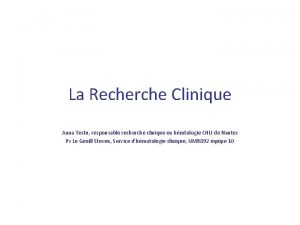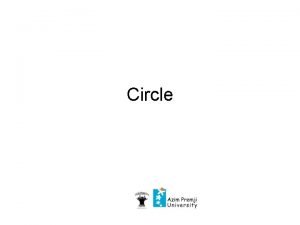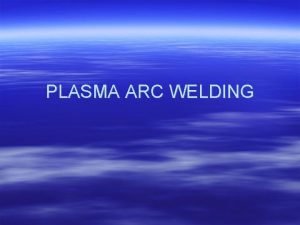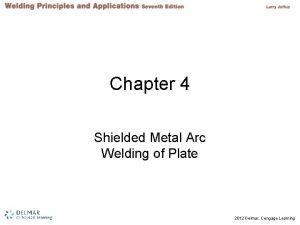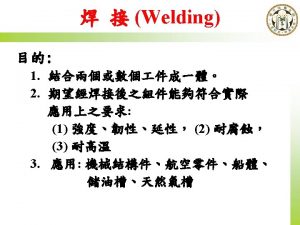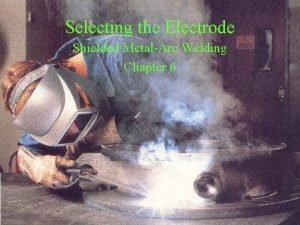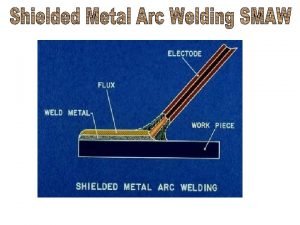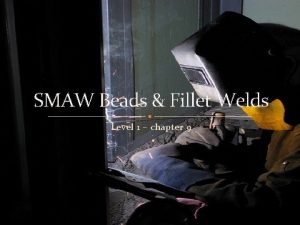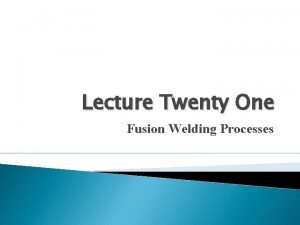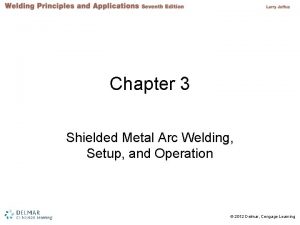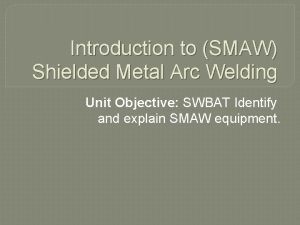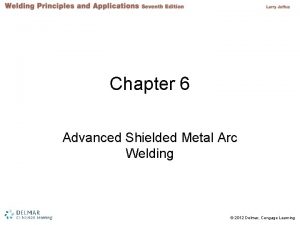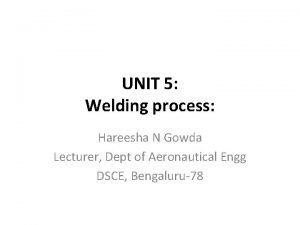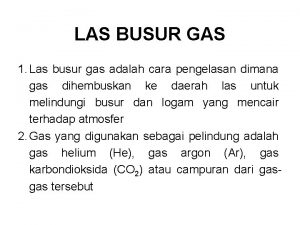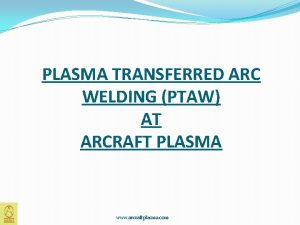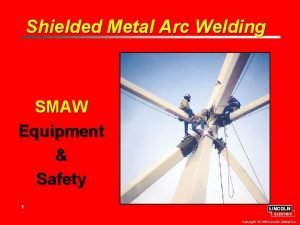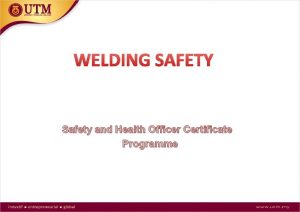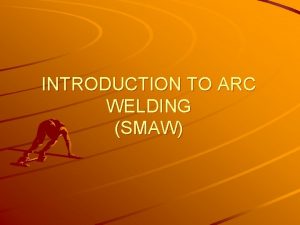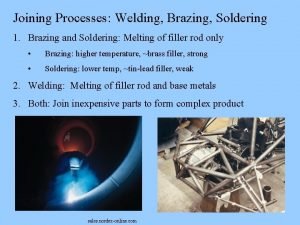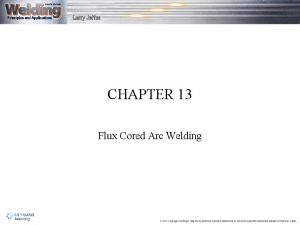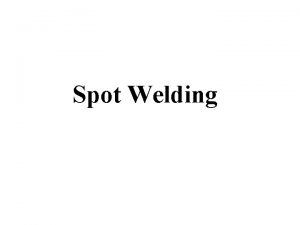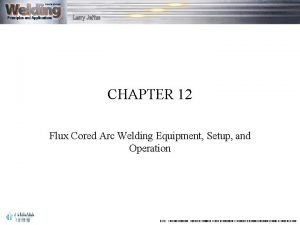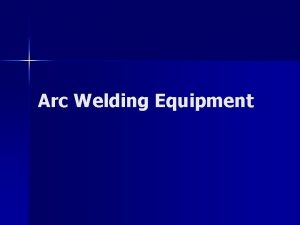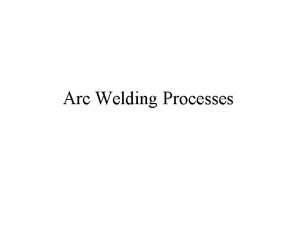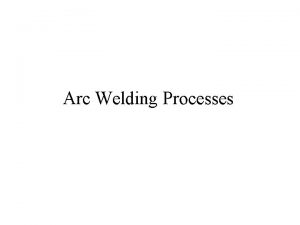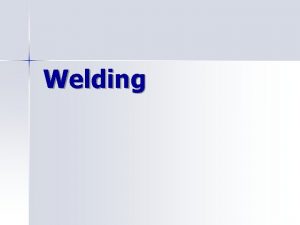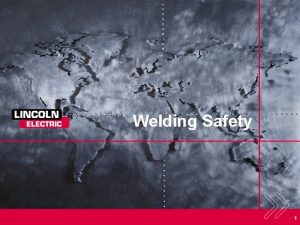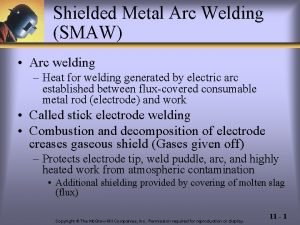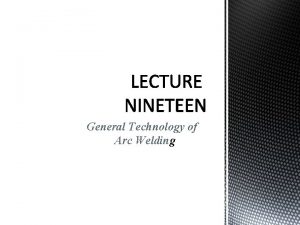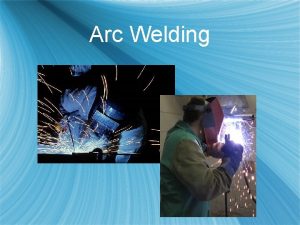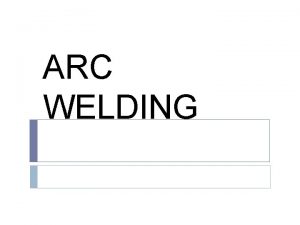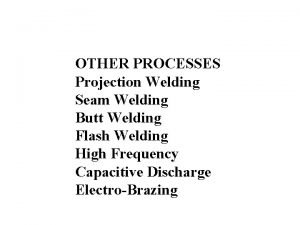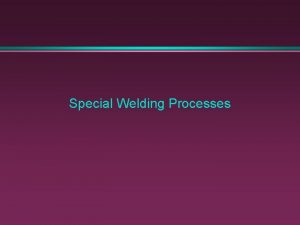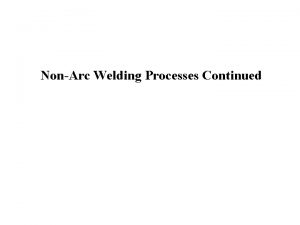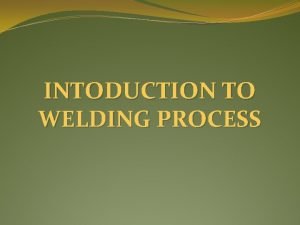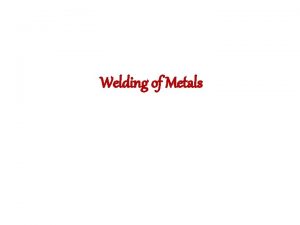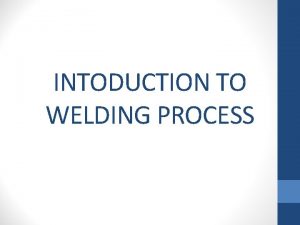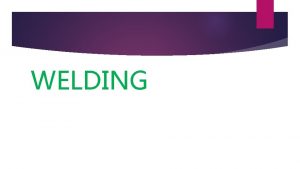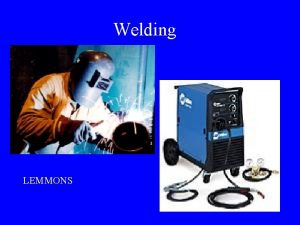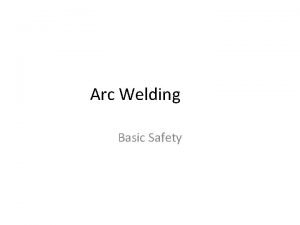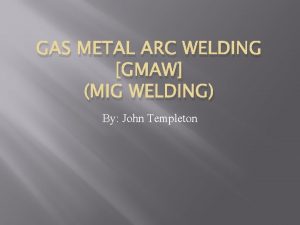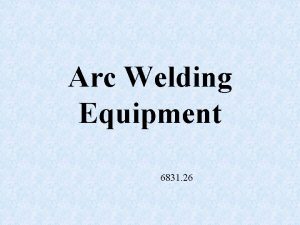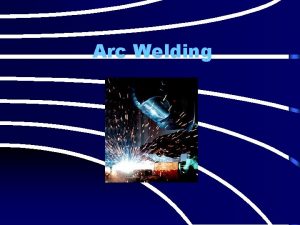WELDING PROCESSES 1 Arc Welding Part 2 2

























- Slides: 25

WELDING PROCESSES 1. Arc Welding Part 2 2. Resistance Welding © 2007 John Wiley & Sons, Inc. M P Groover, Fundamentals of Modern Manufacturing 3/e

Electrogas Welding (EGW) Uses a continuous consumable electrode, either flux‑cored wire or bare with externally supplied shielding gases, and molding shoes to contain molten metal § When flux‑cored electrode wire is used and no external gases are supplied, then special case of self‑shielded FCAW § When a bare electrode wire used with shielding gases from external source, then special case of GMAW © 2007 John Wiley & Sons, Inc. M P Groover, Fundamentals of Modern Manufacturing 3/e

Electrogas Welding Figure 31. 7 Electrogas welding using flux‑cored electrode wire: (a) front view with molding shoe removed for clarity, and (b) side view showing molding shoes on both sides. © 2007 John Wiley & Sons, Inc. M P Groover, Fundamentals of Modern Manufacturing 3/e

Submerged Arc Welding (SAW) Uses a continuous, consumable bare wire electrode, with arc shielding provided by a cover of granular flux § Electrode wire is fed automatically from a coil § Flux introduced into joint slightly ahead of arc by gravity from a hopper § Completely submerges operation, preventing sparks, spatter, and radiation © 2007 John Wiley & Sons, Inc. M P Groover, Fundamentals of Modern Manufacturing 3/e

Submerged Arc Welding Figure 31. 8 Submerged arc welding. © 2007 John Wiley & Sons, Inc. M P Groover, Fundamentals of Modern Manufacturing 3/e

SAW Applications and Products § Steel fabrication of structural shapes (e. g. , I‑beams) § Seams for large diameter pipes, tanks, and pressure vessels § Welded components for heavy machinery § Most steels (except hi C steel) § Not good for nonferrous metals © 2007 John Wiley & Sons, Inc. M P Groover, Fundamentals of Modern Manufacturing 3/e

Nonconsumable Electrode Processes § § Gas Tungsten Arc Welding Plasma Arc Welding Carbon Arc Welding Stud Welding © 2007 John Wiley & Sons, Inc. M P Groover, Fundamentals of Modern Manufacturing 3/e

Gas Tungsten Arc Welding (GTAW) Uses a nonconsumable tungsten electrode and an inert gas for arc shielding § Melting point of tungsten = 3410 C (6170 F) § A. k. a. Tungsten Inert Gas (TIG) welding § In Europe, called "WIG welding" § Used with or without a filler metal § When filler metal used, it is added to weld pool from separate rod or wire § Applications: aluminum and stainless steel most common © 2007 John Wiley & Sons, Inc. M P Groover, Fundamentals of Modern Manufacturing 3/e

Gas Tungsten Arc Welding Figure 31. 9 Gas tungsten arc welding. © 2007 John Wiley & Sons, Inc. M P Groover, Fundamentals of Modern Manufacturing 3/e

Advantages / Disadvantages of GTAW Advantages: § High quality welds for suitable applications § No spatter because no filler metal through arc § Little or no post-weld cleaning because no flux Disadvantages: § Generally slower and more costly than consumable electrode AW processes © 2007 John Wiley & Sons, Inc. M P Groover, Fundamentals of Modern Manufacturing 3/e

Plasma Arc Welding (PAW) Special form of GTAW in which a constricted plasma arc is directed at weld area § Tungsten electrode is contained in a nozzle that focuses a high velocity stream of inert gas (argon) into arc region to form a high velocity, intensely hot plasma arc stream § Temperatures in PAW reach 28, 000 C (50, 000 F), due to constriction of arc, producing a plasma jet of small diameter and very high energy density © 2007 John Wiley & Sons, Inc. M P Groover, Fundamentals of Modern Manufacturing 3/e

Plasma Arc Welding Figure 31. 10 Plasma arc welding (PAW). © 2007 John Wiley & Sons, Inc. M P Groover, Fundamentals of Modern Manufacturing 3/e

Advantages / Disadvantages of PAW Advantages: § Good arc stability § § Better penetration control than other AW High travel speeds Excellent weld quality Can be used to weld almost any metals Disadvantages: § High equipment cost § Larger torch size than other AW § Tends to restrict access in some joints © 2007 John Wiley & Sons, Inc. M P Groover, Fundamentals of Modern Manufacturing 3/e

Resistance Welding (RW) A group of fusion welding processes that use a combination of heat and pressure to accomplish coalescence § Heat generated by electrical resistance to current flow at junction to be welded § Principal RW process is resistance spot welding (RSW) © 2007 John Wiley & Sons, Inc. M P Groover, Fundamentals of Modern Manufacturing 3/e

Resistance Welding Figure 31. 12 Resistance welding, showing the components in spot welding, the main process in the RW group. © 2007 John Wiley & Sons, Inc. M P Groover, Fundamentals of Modern Manufacturing 3/e

Components in Resistance Spot Welding § Parts to be welded (usually sheet metal) § Two opposing electrodes § Means of applying pressure to squeeze parts between electrodes § Power supply from which a controlled current can be applied for a specified time duration © 2007 John Wiley & Sons, Inc. M P Groover, Fundamentals of Modern Manufacturing 3/e

Advantages / Drawbacks of RW Advantages: § No filler metal required § High production rates possible § Lends itself to mechanization and automation § Lower operator skill level than for arc welding § Good repeatability and reliability Disadvantages: § High initial equipment cost § Limited to lap joints for most RW processes © 2007 John Wiley & Sons, Inc. M P Groover, Fundamentals of Modern Manufacturing 3/e

Resistance Spot Welding (RSW) Resistance welding process in which fusion of faying surfaces of a lap joint is achieved at one location by opposing electrodes § Used to join sheet metal parts using a series of spot welds § Widely used in mass production of automobiles, appliances, metal furniture, and other products made of sheet metal § Typical car body has ~ 10, 000 spot welds § Annual production of automobiles in the world is measured in tens of millions of units © 2007 John Wiley & Sons, Inc. M P Groover, Fundamentals of Modern Manufacturing 3/e

Spot Welding Cycle Figure 31. 13 (a) Spot welding cycle, (b) plot of squeezing force & current in cycle (1) parts inserted between electrodes, (2) electrodes close, force applied, (3) current on, (4) current off, (5) electrodes opened. © 2007 John Wiley & Sons, Inc. M P Groover, Fundamentals of Modern Manufacturing 3/e

Resistance Seam Welding (RSEW) Uses rotating wheel electrodes to produce a series of overlapping spot welds along lap joint § Can produce air‑tight joints § Applications: § Gasoline tanks § Automobile mufflers § Various other sheet metal containers © 2007 John Wiley & Sons, Inc. M P Groover, Fundamentals of Modern Manufacturing 3/e

Resistance Seam Welding Figure 31. 15 Resistance seam welding (RSEW). © 2007 John Wiley & Sons, Inc. M P Groover, Fundamentals of Modern Manufacturing 3/e

Resistance Projection Welding (RPW) A resistance welding process in which coalescence occurs at one or more small contact points on parts § Contact points determined by design of parts to be joined § May consist of projections, embossments, or localized intersections of parts © 2007 John Wiley & Sons, Inc. M P Groover, Fundamentals of Modern Manufacturing 3/e

Resistance Projection Welding Figure 31. 17 Resistance projection welding (RPW): (1) start of operation, contact between parts is at projections; (2) when current is applied, weld nuggets similar to spot welding are formed at the projections. © 2007 John Wiley & Sons, Inc. M P Groover, Fundamentals of Modern Manufacturing 3/e

Cross-Wire Welding Figure 31. 18 (b) cross‑wire welding. © 2007 John Wiley & Sons, Inc. M P Groover, Fundamentals of Modern Manufacturing 3/e

Thanks © 2007 John Wiley & Sons, Inc. M P Groover, Fundamentals of Modern Manufacturing 3/e
 Concurrent in os
Concurrent in os Minior arc
Minior arc Arc emu88 com arc info 05 100005 html
Arc emu88 com arc info 05 100005 html Arc promoteur vs arc investigateur
Arc promoteur vs arc investigateur Mentoring circle
Mentoring circle Micro plasma welder
Micro plasma welder Chapter 4 shielded metal arc welding of plate
Chapter 4 shielded metal arc welding of plate What is the fusion zone?
What is the fusion zone? Fill freeze electrode examples
Fill freeze electrode examples Shielded metal arc welding
Shielded metal arc welding Scratching method of striking an arc
Scratching method of striking an arc Fusion arc welding
Fusion arc welding In alternators the welding current is produced on the
In alternators the welding current is produced on the Smaw tools
Smaw tools Chapter 6 advanced shielded metal arc welding
Chapter 6 advanced shielded metal arc welding Welding chapter 3
Welding chapter 3 Disadvantages of leftward welding technique
Disadvantages of leftward welding technique Gas arc regulator
Gas arc regulator Plasma transferred arc welding equipment
Plasma transferred arc welding equipment Shielded metal arc welding safety
Shielded metal arc welding safety Gas welding conclusion
Gas welding conclusion Introduction to smaw
Introduction to smaw Resistance arc welding
Resistance arc welding Welding chapter 13 answers
Welding chapter 13 answers Spot welding basics
Spot welding basics Fcaw-s meaning
Fcaw-s meaning



